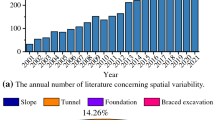Abstract
Slope stability assessment is a difficult geotechnical problem because of the many uncertainties involved. The uncertainties associated with soil parameters are significant, originating from limited and imprecise information, which allows for the soil parameters to be expressed as uncertain variables. The distributions of these uncertain variables are built on the basis of the structure of the soil layers of a slope, and the safety factor of slope stability is defined as a ratio of resisting and acting moments under uncertain environments. The expected value of the safety factor is therefore calculated by utilizing the operational laws of the uncertain variables. The concept of the reliability index of slope stability is also introduced in order to evaluate the risk of slope instability. Three numerical examples, including a homogeneous slope and two non-homogeneous slopes, are used to verify the proposed model; meanwhile, the results are compared with those of the Fellenius method. The numerical results indicate that the proposed model can not only improve the reliability of the calculated safety factor but also reduce the computational complexity compared to deterministic methods. Fifteen project instances taken from the literature are used to investigate the validity of reliability index, and the results illustrate that the reliability index is another useful indicator to assess the stability of a slope.






Similar content being viewed by others
References
Alen C (1996) Application of a probabilistic approach in slope stability analyses. In: Proceedings of the seventh international symposium on Landslides, Trondheim, pp 1137–1142
Bishop AW (1955) The use of slip circle in the stability analysis of slopes. Geotechnique 5:7–17
Chen Z-Y (2003) Stability analysis of soil slope: principle, method and program. China Water Power Press, Beijing (in Chinese)
Cherubini C, Giasi CI, Guadagno FM (1996) Some observations on probabilistic approaches for slope stability analysis in typical geomorphological settings of Southern Italy. In: Proceedings of the seventh international congress of the IAEG, Lisbon, pp 1173–1176
Chowdhury RN (1984) Recent developments in landslide studies: probabilistic methods. In: State of the art report-session VII(a), International symposium on Landslides, Toronto, pp 209–228
Dodagoudar GR, Venkatachalam G (2000) Reliability analysis of slopes using fuzzy sets theory. Comput Geotech 272:101–115
Duncan JM, Wright SG (2005) Soil strength and slope stability. Wiley, New Jersey
Fellenius W (1936) Calculation of the stability of earth slope. In: Transactions of 2nd congress on Large dams, Washington, DC, pp 445–462
Gao Y, Qin Z (2016) A chance constrained programming approach for uncertain \(p\)-hub center location problem. Computers&. Ind Eng 102:10–20
Giasi CI, Masi P, Cherubini C (2003) Probabilistic and fuzzy reliability analysis of a sample slope near Aliano. Eng Geol 67(3–4):391–402
Harr ME (1995) Accounting for variability (reliability). In: Chen WF (ed) The civil engineering hand-book. CRC Press, Boca Raton, pp 683–704
Janbu N (1954) Application of composite slip surface for stability analysis. In: Proceedings of European conference on stability of earth slopes, Stockholm, pp 43–49
Juang CH, Jhi YY, Lee DH (1998) Stability analysis of existing slopes considering uncertainty. Eng Geol 49(2):111–122
Kacewicz M (1987) Fuzzy slope stability method. Math Geol 19(8):757–767
Li KS, Lumb P (1987) Probabilistic design of slopes. Can Geotech J 24(4):520–535
Liu B (2007) Uncertainty theory, 2nd edn. Springer, Berlin
Liu B (2010) Uncertainty theory: a branch of mathematics for modeling human uncertainty. Springer, Berlin
Liu Z, Zhao R, Liu X, Chen L (2016) Contract designing for a supply chain with uncertain information based on confidence level. Appl Soft Comput. doi:10.1016/j.asoc.2016.05.054
Malkawi AIH, Hassan WF, Abdulla FA (2000) Uncertainty and reliability analysis applied to slope stability. Struct Saf 22(2):161–187
Mostyn GR, Li KS (1993) Probabilistic slope analysis State of Play. In: Proceedings of the conference on probabilistic methods in geotechnical engineering, Canberra, pp 89–109
Pijush S (2008) Slope stability analysis: a support vector machine approach. Environ Geol 56:255–267
Shen Q, Zhao R (2010) Risk assessment of serious crime with fuzzy random theory. Infor Sci Int J 180(22):4401–4411
Spencer EE (1967) A method of the analysis of the stability of embankments assuming parallel inter-slice forces. Geotechnique 17:11–26
Wu X, Zhao R, Tang W (2014) Uncertain agency models with multi-dimensional incomplete information based on confidence level. Fuzzy Optim Decis Making 13(2):231–258
Wu X, Zhao R, Tang W (2014) Optimal contracts for the agency problem with multiple uncertain information. Knowl-Based Syst 59(2):161–172
Yang K, Zhao R, Lan Y (2014) The impact of risk attitude in new product development under dual information asymmetry. Computers&. Ind Eng 76(3):122–137
Yu YF, Mostyn GR(1996) An extended point estimate method for the determination of the probability of failure of a slope. In: Proceedings of the seventh international symposium on Landslides, Trondheim, pp 429–433
Acknowledgements
This study was funded by the National Natural Science Foundation of China (Grant Numbers 71471126, 11172088), Hubei Province Natural Science Foundation of Key Project (Grant Number 2015CFA144) and Huanggang Normal University Natural Science Foundation (Grant Number 201617603).
Author information
Authors and Affiliations
Corresponding author
Ethics declarations
Conflict of interest
The authors declare that they have no conflict of interests.
Ethical approval
This article does not contain any studies with human participants or animals performed by any of the authors.
Additional information
Communicated by Y. Ni.
Rights and permissions
About this article
Cite this article
Zhou, X., Huang, W., Liu, Z. et al. Assessment of slope stability under uncertain circumstances. Soft Comput 22, 5735–5745 (2018). https://doi.org/10.1007/s00500-017-2620-9
Published:
Issue Date:
DOI: https://doi.org/10.1007/s00500-017-2620-9




